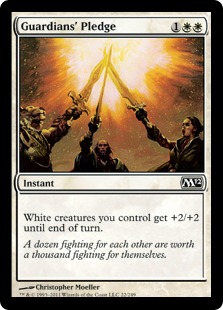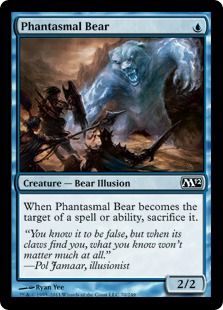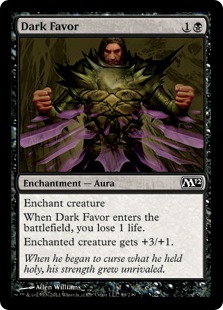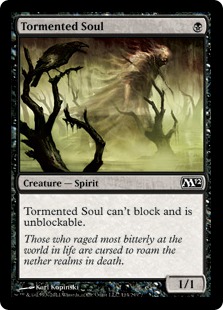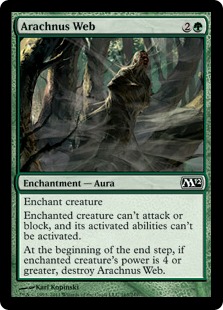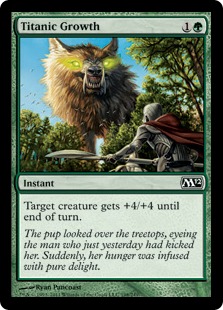(Warning: Contains Spoilers)
On June 20, Wizards banned three cards. Jace, the Mind Sculptor and Stoneforge Mystic were removed from Standard. Frantic Search was banned in Pauper.
Guess which items got all the headlines?
Frantic Search is the player to be named later in the June 20 trade deadline. It is the free mouse pad with $100 dollar purchase. Or at least that is
how it appears to a large portion of the Magic audience. For Pauper Magicians, it signified the end of an era.
When Urza’s Legacy burst on to the scene, one of the first new decks to pop up was a combo deck featuring cards such as Utopia Sprawl and Fertile
Ground—in conjunction with Cloud of Faeries, Frantic Search, and Snap—to generate a large amount of mana, allowing a deck to cast Rolling Thunder for
the win as early as turn five. That deck put up respectable numbers, but a few players kept tuning it, uncovering the monster known as Frantic Storm.
While Pauper was a wide-open format, even with Frantic Search as a viable option, the existence of the deck warped the format in ways that were not
healthy. I contend that a format where a one-sided Obliterate is common qualifies as “not healthy.”
The combo was incredibly hard to disrupt. The entire deck was wholly synergistic; even the lands contributed to “going off.” Every card either built
storm count, generated mana, and one did all three: Frantic Search. The combo targeted permanents, and very few of those have shroud (or hexproof) and
are cheap enough to race a deck that could win on turn four.
In an ideal situation—three Ravnica bouncelands, two familiars—one Frantic Search could generate eleven mana, and then filter away unneeded lands. No
other card in the deck could move towards the endgame on all metrics in such a way.
Storm is also not a “common” mechanic. The tools that other formats have to fight free spells do not exist in Pauper. This makes perfect sense, as
commons are supposed to be the bread and butter of Magic—the cards players of all stripes will know and understand. Yes, Hindering Touch exists, but it
was too slow, very easy to play around, and is not a hard counter. Cards like Duress and Distress could not take out enough pieces, since the deck was
incredibly redundant. Unlike traditional Storm, ripping a key card would barely buy a turn, as Mnemonic Wall could rebuy a key spell, and any other
card lost, well, could be easily replaced with an analogue.
The deck also warped the metagame. While I, personally, am a fan of viable land destruction strategies, having Stone Rain spells be a corner stone
severely limits the crop of potential decks AND potential colors. When Mono-Green Post, a deck featuring as many as twelve spells focused exclusively
on destroying lands, is putting up respectable numbers simply because it can combat Frantic Storm, something is wrong. Such decks only existed to fight
bouncelands and had glaring holes against other pillars of the format.
Finally, the deck was not fun to play against. There is little worse than being a turn away from winning, only to have your board reset to the start of
the game, facing down that prospect every turn as your life total is whittled away by 1/1s and 2/2s. As Wizards has shown, when formats cease to be
fun, something has to be done. At the end of the day, Magic is a game.
Why Frantic Search? While I have not seen any official word, I have to think this card got the axe because of the insane amount of mana it could
generate. As mentioned, in an ideal situation, which is not difficult to achieve in Pauper, this one spell can generate eleven mana. Even with three
basics and two Familiars, Search could generate five mana, which is enough to cast the game winning spell. Add to this the “free” Snap and Cloud of
Faeries, and the engine is in full swing.
Snap would often target Cloud or a Sea Gate Oracle or Mulldrifter, netting mana or cards, which would in turn lead to more mana or more cards. Frantic
Search, however, could help get rid of land, while simultaneously moving the engine along. Taking it away only hurts this deck, whereas both Snap and
Cloud of Faeries see sporadic play in blue aggressive strategies as board control of Ninja of the Deep Hours enablers. While search saw some play in
certain blue Cloudpost-based decks, it was not a key cog in that machine.
What about Temporal Fissure? This card, while incredibly strong, has been in Pauper since before it was a sanctioned format, and yet, was only exposed
when Frantic Search entered the format. If Fissure left, Frantic decks would probably revert to an arbitrarily large mana engine or utilize another
Storm kill card, such as Empty the Warrens.
But this is just speculation, and I for one would love an official word on why Frantic got booted (hint hint, anyone? Crickets?).
The question then becomes: What does the loss of a key deck do to the format? There are two answers to this: the shift in power and what will actually
happen.
What will actually happen is easier to answer, and slightly more fun. The answer is: very little. Pauper resembles Legacy in many ways. One such way is
that people will play their favorite deck—they invest ego with greater ease. Perhaps this is because the format has an air of casual, but people get
attached to their decks. When the decks have fairly even matchups across the entire board, it is more important to understand how your weapon fares
against the field. This is perhaps one reason why many people continued to run their pet deck against a field that contained Frantic Storm, regardless
of actual chance for winning (and maybe Frantic was just much better than everyone thought). Yes, people can stop packing excessive land destruction in
their sideboards, but looking at the results of the Daily Events in the days after Frantic’s banning, all decks were present, except for the one that
had its heart cut out. Will some decks rise up? Quite likely, but in the meanwhile, the actual meta will not shift dramatically.
However, there will be some subtle waves. Perhaps the most important is that traditional Storm gets worse. Traditional Storm wins with a combination of
Grapeshot or Empty the Warrens. While ETW is easier to answer in Pauper, the combo player only has to generate between 10-14 spells before going for
the kill; Grapeshot—while more final, as the damage is harder to prevent—requires two Grapeshots or a storm count that approaches 20, which while
feasible, is not as easy to attain.
Unlike Frantic Storm, this genus of decks is far more susceptible to discard. A well-timed Duress can often buy the defender one or two turns, which
can swing the game. Unlike Frantic, sideboard slots that are strong against Traditional Storm are good against other decks—discard also works against
control; sweepers are helpful against aggro decks and swarms.
When Storm has a target on its head, it is rather easy to hate to a corner of the metagame. When Paupers are busy destroying land, ritual-based decks
will thrive. Without slots dedicated to destroying lands, the full brunt of combo hate can now be hurled at the decks that kill with Storm cards,
instead of killing you with puny creatures.
Because of this, other decks get better. IzzetPost decks can remove cards like Stone Rain and Earth Rift from their 75, allowing them to fill more
slots to fight the format. Slower decks can make a comeback, now that the format has returned to a more reasonable speed.
Goblins, the former king of the hill, is likely to become a major player once again. Goblins would often have a strong first game against Frantic, but
a sideboard plan of Galina’s Knight and Steel of the Godhead would make very short work of the little red men. Eventually, Frantic started packing Lone
Missionary, and with the ability to bounce it multiple times, Goblins stood little chance. Now, while those cards still exist, they are not going to be
the backup to a strong combo. Goblins is poised to make a return.
It will be interesting to see Pauper take shape in the coming weeks. New decks are sure to appear, and hopefully the meta will achieve a better sense
of balance.
WARNING- M12 SPOILERS AHEAD
Â
M12 is right around the corner, and with it will come some new commons. Many of these will see heavy play in Limited, but not impact Pauper. The Core
Sets rarely have ground-breaking commons, but every so often, a nugget of gold can be found.
White Weenie is already a fringe deck, but the ability to pump the army at instant speed is enticing. Most effects of this nature are +1/+1 and affect
all creatures, and the extra points of power could be incredibly swingy. That being said, WW is more likely to win with a few creatures, rather than a
swarm like Goblins. Definitely a card to keep your eye on however, if WW can adapt to a deck that vomits creatures on to the board, as it can do thanks
to a bevy or strong one-drops (Akrasan Squire, Icatian Javelineers, Benevolent Bodyguard, Steppe Lynx, just to name a few).
A strong one-drop, especially in a format where most spells that can target it would kill it outright anyway. What makes this even more interesting is
that blue has Krovikan Mist, an Illusion creature for 1U with flying and that has power and toughness equal to the number of Illusions in play. While
the other Illusions available are not so hot, if this is a plant for future sets, blue Illusion aggro could be a deck to watch.
This card appeals to me as an old-time Hatred player. While not good enough to see play in a format with so much creature removal, the potential for
three additional power on certain hexproof creatures is exciting, if fragile.
I am a big proponent of Vicious Hunger when non-Goblin aggro decks are running around, and this is a strict upgrade. As long as Mogg Raider and Goblin
Sledder are around, however, the Thirst will not be quenched.
If that Dark Ritual powered aggro-black deck ever appears, this is a candidate for one-drop, provided there’s a Bonesplitter to pick up at some point.
Also fantastic at enabling a turn-two Ninja of the Deep Hours, if the mana works that is.
In Pauper, this is basically Arrest for green. Very few creatures will have more than four power outside of Affinity, and green has the tools to fight
artifacts. While three mana is too much for a Pacifism, it is a viable option and might see some play if mono-green is desperate for a way to negate
blockers.
Groundswell sees serious play in both Stompy and Infect. Titanic Growth gives all the upside, but without requiring an additional land drop. Seeing as
both these decks are mana light, I do not think that T. Growth will replace Groundswell anytime soon, but will likely appear as a supplemental way to
make creatures that much nastier.
Cards leave, and cards enter, and the format goes on.
Keep slingin’ commons—
Alex
Â
SpikeBoyM on MTGO
@NerdtotheCore on Twitter

